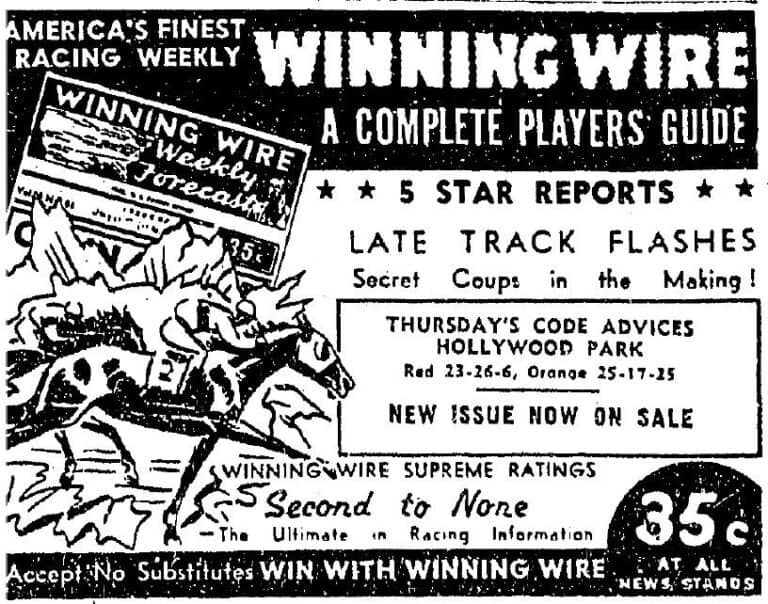
What Was Bugsy Siegel's Race Wire in Las Vegas and Why Was It Significant?
Bugsy Siegel, synonymous with Las Vegas, played a pivotal role in shaping the city’s gaming industry. An integral contribution was the establishment of the race wire, a groundbreaking system that revolutionized sports betting in the United States.
Bugsy Siegel: A Brief Overview
Born in 1906 in Brooklyn, New York, Siegel immersed himself in organized crime from a young age. Part of the infamous Murder, Inc. gang and deeply involved in Prohibition-era bootlegging, he later became a prominent figure in Los Angeles’ organized crime scene. During the 1940s, Siegel envisioned a unique gambling destination in the Nevada desert.
The Race Wire: Unveiling Real-Time Sports Betting
The race wire was a telegraph system transmitting real-time information about horse races and sporting events nationwide. Siegel recognized its potential to bring sports betting to Las Vegas, allowing customers to wager on events happening thousands of miles away, transforming the city’s gambling landscape.
How the Race Wire Operated
This innovative system worked by relaying information from tracks to Las Vegas bookmakers. Siegel and his associates paid insiders at the tracks to promptly provide race results, transmitted over the race wire to bookmakers. This ensured that customers could place bets on live events, offering an unprecedented real-time betting experience.
Significance of the Race Wire
Up-to-Date Information: Bookmakers in Las Vegas could provide customers with the latest information, enhancing the excitement of sports betting.
Expanded Betting Options: The race wire enabled bookmakers to offer a diverse range of bets on various events, broadening the scope of wagering possibilities.
Cementing Las Vegas’s Gambling Reputation: The race wire played a pivotal role in solidifying Las Vegas’s status as a premier gambling destination. This contributed to the city’s growth, ultimately evolving into the entertainment capital of the world.
Bugsy Siegel’s race wire left an indelible mark on the sports betting landscape in the United States. The use of telegraph technology to transmit real-time sporting event information transformed the betting experience in Las Vegas. Today, the legacy of the race wire endures in modern sports betting technology, allowing enthusiasts to wager on events unfolding worldwide.
UK Sports Betting:

32Red UK Sportsbook: A Grand Symphony of Betting Excellence

Exploring Motorsport Betting in the UK: Unleashing the Thrills on the Track and Wagering Fun

Exploring Rugby Betting in the UK: A Comprehensive Overview

UK Boxing Betting: A Comprehensive Guide

Exploring Cricket Betting in the UK: An In-Depth Guide

Exploring UK Horse Racing Betting: A Comprehensive Overview
Frequently Asked Questions (FAQs):
1. Who was Bugsy Siegel, and why is he associated with Las Vegas?
Bugsy Siegel was a notorious figure in organized crime who played a crucial role in shaping Las Vegas. He is particularly associated with the city due to his contributions to its gaming industry.
2. What is the race wire, and how did Bugsy Siegel use it in Las Vegas?
The race wire was a telegraph system transmitting real-time information about sporting events. Siegel utilized it to offer customers in Las Vegas the ability to bet on live events happening across the country.
3. How did Bugsy Siegel’s involvement in the race wire impact sports betting?
Siegel’s race wire revolutionized sports betting by providing up-to-date information, making the betting experience more engaging and exciting for customers.
4. What motivated Bugsy Siegel to establish the race wire in Las Vegas?
Siegel’s vision was to create a unique gambling destination in the Nevada desert. The race wire was a key element in realizing this vision, allowing Las Vegas to offer cutting-edge sports betting.
5. Can you explain how the race wire operated?
The race wire worked by transmitting race results from tracks to Las Vegas bookmakers in real-time, enabling customers to place bets on live events as they unfolded.
6. Why was the race wire considered significant in the context of sports betting?
The race wire was significant for its role in providing the most current information, expanding betting options, and contributing to Las Vegas’s reputation as a premier gambling destination.
7. Did Bugsy Siegel’s race wire have a lasting impact on the sports betting industry?
Yes, Bugsy Siegel’s race wire had a lasting impact, and its legacy is seen in modern sports betting technology, allowing users to wager on events worldwide in real-time.
8. What other contributions did Bugsy Siegel make to Las Vegas?
Aside from the race wire, Siegel built the Flamingo Hotel and Casino, marking his contribution to establishing Las Vegas as a hub of luxury and entertainment.
9. How did the race wire contribute to the growth of Las Vegas as an entertainment capital?
By enhancing the betting experience and solidifying Las Vegas’s reputation, the race wire played a role in the city’s growth into the entertainment capital of the world.
10. Is the legacy of Bugsy Siegel’s race wire still present in today’s sports betting landscape?
Yes, the legacy endures in modern sports betting technology, showcasing the pioneering impact of Bugsy Siegel’s innovations on the industry.





